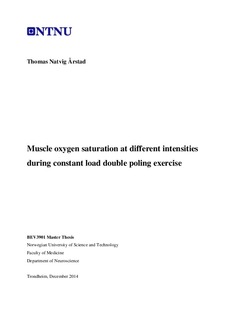| dc.description.abstract | Purpose: The present study investigated the effects of constant load exercise at three different intensities on muscle oxygen saturation in the arm (triceps brachii, TB) and the leg (vastus lateralis, VL) during simulated double poling (DP). Methods: Nine male elite cross country skiers with a VO2max of 74.5 ± 3.8 ml/kg/min performed two submaximal 4-minute intervals at low (LOW) and moderate (MOD) intensity, and one steady rate maximal all-out (MAX) 3-minute interval. Muscle oxygen saturation in TB and VL was measured during exercise by near-infrared spectroscopy. Results: The response in muscle oxygen saturation was different for TB and VL in relation to intensity. TB displayed a clear desaturation already at LOW and thereafter showed no further significant desaturation. However, a trend of further desaturation from LOW to MOD to MAX was evident. VL on the other hand showed no desaturation in LOW, a slight desaturation in MOD and a clear desaturation in MAX. In addition, the desaturation pattern during MAX, where both muscles displayed a clear desaturation, were different between the two muscles. TB showed a rapid desaturation at the onset of exercise, unlike VL that gradually desaturated throughout the whole exercise period. Discussion: The difference in muscle oxygenation desaturation in relation to intensity between TB and VL was in agreement with other studies investigating oxygen saturation in these muscles. However, it should be noted that very little research has been done on DP specifically, and the present study revealed similar differences as other studies obtained during arm cranking and cycling. The desaturation pattern of TB during maximal DP was in agreement with previous literature. In contrast, the desaturation pattern in VL during MAX has not been observed in previous studies investigating steady rate exercise. However, DP differs from cycling, and the subjects in the present study might have adjusted their DP technique to involve increasingly more leg-work as they became fatigued during the maximal DP-period. Conclusion: The present study has provided more insight into the physiological responses and processes in arm and leg during DP. The present study found a difference in muscle oxygen saturation in TB and VL in relation to intensity during simulated DP. It was also found a difference in the desaturation pattern between TB and VL during maximal DP exercise, but the mechanism behind this remains unclear.
Key words: Near-infrared spectroscopy, muscle oxygen saturation, m. triceps brachii, m. vastus lateralis, double poling exercise, cross country skiing | nb_NO |
